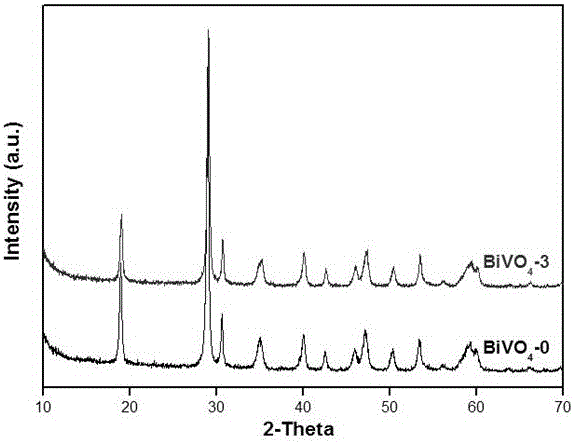Method for preparing monoclinic bismuth vanadate visible light catalyst
A technology of monoclinic crystal and visible light, applied in chemical instruments and methods, physical/chemical process catalysts, chemical/physical processes, etc., can solve problems such as inefficient use of sunlight, wide band gap, and difficulty in excitation. Achieve the effect of good crystal form and light absorption performance
- Summary
- Abstract
- Description
- Claims
- Application Information
AI Technical Summary
Problems solved by technology
Method used
Image
Examples
Embodiment 1
[0010] 5mmol Bi(NO 3 ) 3 ·5H 2 O dissolved in 15 mL of HNO with a molar concentration of 1 mol / L 3 Solution A was prepared in the solution; 5mmol NH 4 VO 3 Solution B was prepared by dissolving in 40mL water under ultrasonic conditions; under stirring conditions, add solution B to solution A, continue to stir for 30min, then transfer the mixed solution into a polytetrafluoroethylene reactor, and react at 180°C After 18 hours, after the reaction was completed, it was naturally cooled to room temperature, separated by filtration, washed with water and ethanol three times respectively, then dried in a constant temperature drying oven at 60°C, and finally calcined at 500°C for 4 hours to obtain a visible photocatalyst of monoclinic bismuth vanadate, labeled for BiVO 4 -0. After 6 hours of natural sunlight irradiation, the decolorization rate of RhB by the bismuth vanadate visible photocatalyst was 86.5%.
Embodiment 2
[0012] 5mmol Bi(NO 3 ) 3 ·5H 2 O dissolved in 15 mL of HNO with a molar concentration of 1 mol / L 3 Solution A was prepared in the solution; 5mmol NH 4 VO 3 Solution B was prepared by dissolving in 40mL water under ultrasonic conditions; under stirring conditions, add solution B to solution A, continue stirring for 30min, and adjust the pH of the mixture to 1 with NaOH solution with a molar concentration of 2mol / L. Continue to stir for 30 minutes, then transfer the mixed solution into a polytetrafluoroethylene reactor, react at 180 ° C for 18 hours, naturally cool to room temperature after the reaction is completed, filter and separate, wash with water and ethanol three times, and then dry in a constant temperature oven at 60 ℃ drying, and finally calcined at 500 ℃ for 4h to obtain monoclinic bismuth vanadate visible light catalyst, marked as BiVO 4 -1. After 6 hours of natural sunlight irradiation, the decolorization rate of RhB by the bismuth vanadate visible photocatal...
Embodiment 3
[0014] 5mmol Bi(NO 3 ) 3 ·5H 2 O dissolved in 15 mL of HNO with a molar concentration of 1 mol / L 3 Solution A was prepared in the solution; 5mmol NH 4 VO 3 Solution B was prepared by dissolving in 40mL water under ultrasonic conditions; under stirring conditions, add solution B to solution A, continue stirring for 30 min, and adjust the pH of the mixture to 3 with NaOH solution with a molar concentration of 2mol / L , continue to stir for 30 minutes, then transfer the mixed solution into a polytetrafluoroethylene reactor, and react at 180°C for 18 hours. Dry at 60°C, and finally calcined at 500°C for 4 hours to obtain a monoclinic bismuth vanadate visible light catalyst, marked as BiVO 4 -3. After 6 hours of natural sunlight irradiation, the decolorization rate of RhB by the bismuth vanadate visible photocatalyst was 99.5%.
PUM
| Property | Measurement | Unit |
|---|---|---|
| decolorization rate | aaaaa | aaaaa |
| decolorization rate | aaaaa | aaaaa |
| decolorization rate | aaaaa | aaaaa |
Abstract
Description
Claims
Application Information
 Login to View More
Login to View More - R&D Engineer
- R&D Manager
- IP Professional
- Industry Leading Data Capabilities
- Powerful AI technology
- Patent DNA Extraction
Browse by: Latest US Patents, China's latest patents, Technical Efficacy Thesaurus, Application Domain, Technology Topic, Popular Technical Reports.
© 2024 PatSnap. All rights reserved.Legal|Privacy policy|Modern Slavery Act Transparency Statement|Sitemap|About US| Contact US: help@patsnap.com








